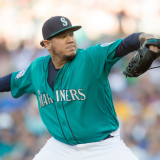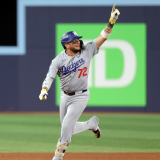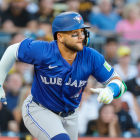MLB Wild Card Series X-factors: Royals, Brewers have game-changing speed, Padres with upper hand vs. Braves
The MLB playoffs begin Tuesday as the four best-of-three Wild Card Series get underway

Major League Baseball's postseason will get underway today with the beginning of the wild-card round. Under MLB's expanded playoff format, the top two teams in each league get byes; the other four clubs then play a best-of-three series, with all of those games being hosted at the higher seed's ballpark to eliminate the need for travel days. (You can find MLB's complete postseason schedule by clicking here and the 2024 bracket here.)
The arrival of the playoffs means that it's time to dust off one of our favorite October pieces: series x-factors. Before each round, we like to identify one plausible X-factor from each series that could swing the outcome. What is an "X-factor"? Why, dear reader, it's a conveniently vague term that allows us to write about darn near any angle that we want to without having to provide additional justification.
To be serious though: we tend to aim for under-the-radar or more granular components that tend to pit strength versus strength or strength versus weakness
With that mumbo jumbo out of the way, let's get to it.
Detroit Tigers vs. Houston Astros
The X-factor: Upper-half fastballs
On paper, the Astros would appear to have an advantage whenever their pitchers attack the Tigers with elevated fastballs. During the regular season, Houston's staff threw the sixth-highest percentage of upper-half fastballs (as defined by TruMedia) in the majors. Conversely, Detroit's hitters posted the third-worst OPS against that offering.
While the Astros as a staff throw a below-average amount of fastballs (we're including sinkers in that grouping), this matchup would appear to be favorable to the likes of Justin Verlander, Hunter Brown, and Ronel Blanco -- each of whom chucked at least 65% of their heaters in the upper half of the zone.
Be that as it may be, we should note that this statistic could be a smidge unfair to the Tigers given the personnel changes they've made to their lineup over the last couple months Some of the worst-performing Tigers on elevated fastballs -- Gio Urshela, Javier Báez, Zach McKinstry included -- are either no longer in the fold or are unlikely to play a big role in the postseason. On the other hand, some of Detroit's late-season additions, like Jace Jung and Parker Meadows, were among their best-performing bats.
All this to say that, yes, the Astros could still have an upper hand when it comes to the upper half, but the effect might be overstated by those introductory ranks.
Kansas City Royals vs. Baltimore Orioles
The X-factor: The running game
We mean "running game" in two respects. The Royals happened to rank 11th in stolen bases thanks to 30-steal efforts from three players (Bobby Witt Jr., Maikel Garcia, and Dairon Blanco). They also ranked third in the majors in extra-base taken percentage, a fancy way of saying that they're adept at taking one more base than the hit type requires -- so, going from first to third or second to home on a single, for example.
Kansas City's wheels will be opposed by an interesting defensive matchup. Catcher Adley Rutschman threw out just 19% of perspective basestealers this season (the league-average mark was 22%). Don't pin the blame on him. Bases tend to be stolen on pitchers who are either inattentive or who are slow to the plate. Statcast's data indicates that Rutschman's average thief was tied for the shortest distance between first and second base when the ball crossed the plate in the majors, at 54.7 feet.
Statcast, in turn, estimates that Rutschman actually threw out one more basestealer this season than he would have been expected to based on leads and speed. It'll be up to the Orioles pitchers to do a better job of keeping the Royals' runners -- and particularly the trio of Witt, Garcia, and Blanco -- tethered to the bag.
As for the run of play aspect, we'll just note that the Orioles have some quality outfield arms to deploy. Colton Cowser led the club with a 93.1 mph average throw velocity (the positional average is 88 mph), making him a sensible choice to stick in left, where he can cut down runners trying to take advantage of Walltimore. Meanwhile, right fielder Anthony Santander maxed out at 99.7 mph, suggesting he can zip it in there when needed. Center fielder Cedric Mullins possessed the only well-below-average arm of the bunch, as even Heston Kjerstad had a 91.4 mph average at the big-league level.
Atlanta Braves vs. San Diego Padres
The X-factor: Breaking balls
Get ready to see a lot of bendy pitches over the two to three games played between the Braves and the Padres. That's because these two pitching staffs ranked Nos. 1 and 2 in breaking ball usage during the regular season. The Braves led the way, chucking just under 40% sliders, curves, and sweepers; the Padres checked in at 36%.
Which lineup did a better job against breaking balls during the regular season? The Padres, and it wasn't particularly close.
San Diego's hitters batted .249/.293/.420, good for a majors-leading .713 OPS. Jurickson Profar and Jake Cronenworth both had OPS over .800 against breakers, while Fernando Tatis Jr. and Jackson Merrill each cleared the .750 mark.
Conversely, the Braves ranked 23rd in performance against breaking balls. Marcell Ozuna and Michael Harris II were the only active Atlanta batters with an OPS above .750. Ramon Laureano, Sean Murphy, Ozzie Albies, Jarred Kelenic, Whit Merrifield, Gio Urshela, and Eli White all finished with marks of .600 or below.
If those trends hold up, there's a real opportunity for San Diego's pitchers -- namely Dylan Cease, Yu Darvish, Tanner Scott, and Joe Musgrove -- to bend and sweep their way through most of the Braves' injury-ridden lineup.
New York Mets vs. Milwaukee Brewers
The X-factor: Basestealing
We know, we know, we used the running game earlier in the piece already. We're turning to stolen bases again because it makes too much sense. The Brewers ranked second in the majors in steals during the regular season; the Mets, on the other paw, allowed the fifth-most stolen bases.
There's a world of difference between what the Orioles will have to prepare for against the Royals -- a team that had three big-time basestealing threats -- and what the Mets will have to deal with vs. the Brewers. Milwaukee had five players who stole at least 20 bases this season, as well as nine who took double-digits. Almost everyone who will be suiting up for the Brewers can run a bit.
As we noted above, bases tend to be stolen against pitchers, not catchers. Predictably, the Mets had some of the worst pitchers in the majors at preventing advances, according to Statcast's measurements.
That includes starter Sean Manaea and relievers Edwin Díaz and Adam Ottavino. Given that Díaz is certain to appear in only high-leverage situations, things could get very, very interesting if Milwaukee is able to reach base and take advantage of his casual attitude toward stopping baserunners.


















